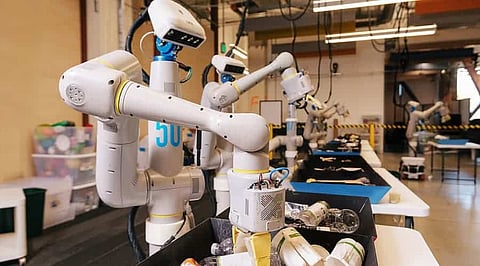
- Insights
- Cryptocurrencies
- Stocks
- White Papers
- Industry
- Geography
- Insights
- Cryptocurrencies
- Stocks
- White Papers
- Industry
- Geography


The world is a gigantic landfill! Everyday tons of waste are generated from various households, hospitals, industries, construction and demolition sites and more. While today we have numerous ways to get rid of the accumulated waste, it still ends up affecting the safety and sustainability of the ecological system. Therefore, the best alternative is to reuse and recycle as much waste as possible. And offering an extra pair of hand in this are waste sorting and recycling robots.
Robotics led-automation has seeped through every industrial sector and routine tasks. Now robots are rapidly disrupting recycling industry too. These robots are adept at multitasking, scalable and have integrated learning systems that can function tirelessly 24/7. This implies they can be extensively deployed for waste processing and recycling in a cohort of industries. These recycling robots are fast, accurate, and can process a heavy load of waste material. Moreover, they have a high number of picks per hour, and can work in different shifts with the same accuracy.
In 2011, the Finnish company ZenRobotics ventured into the automated waste management with their robotic waste sorter. The company's system uses robotic arms suspended from a framework above conveyor belts. This system is equipped with an assortment of computer vision, machine learning, artificial intelligence (AI) to run synchronized robotic arms to sort and pick recycled materials from moving conveyor belts. Each arm has a pincher to grab and toss material into chutes after sorting items using real-time data from metal sensors, 3D laser cameras and spectroscopic cameras.
Appingedam, Netherlands-based Bollegraaf Recycling Solutions, which started experimenting with concept of recycling robots in 1990s, also uses a combination of near-infrared and height cameras to identify items by material and through 3-D detection.
In US, the first waste sorting robot Clarke was installed in 2016, by Denver-based AMP Robotics who had trial tested its robot at Alpine Waste & Recycling's Altogether MRF (Materials Recovery Facility) near Denver. Clarke leverages AI software (AMP Neuron platform) to distinguish a wide variety of food and beverage cartons so it can grab and separate them from the rest of the recycling. By the following year Clarke had improved its recycling skills, grabbing approximately 60 cartons per minute with near perfect accuracy.
Since then the trend of recycling robots continues to build. And behind this milestone, is a combined effort of researchers bridging mechanical, magnetic and laser-optical techniques to achieve this end goal. Last year, MIT's Computer Science and Artificial Intelligence Lab (CSAIL) developed a recycling robot, ROCycle, which relies on sensors in its Teflon hand to determine the nature of an item and sort it accordingly. The inspiration behind ROCycle was born out of a preoccupation for the human workers sorting through rubbish on dirty and, often, unsafe conveyor belts. ROCycle's tactile strain sensor gauges an object's size, while two pressure sensors determine how squishy that object may be, whether it's easily-crushed paper or more rigid plastic. Due to the conductive nature of the sensors, it can also detect the presence of metal.
As per official sources of MIT, ROCycle has an 85% success rate when objects are stationary, however if the conveyor belt is in motion, it drops to 63%. Further, when set to differentiate between hard and soft objects, ROCycle has a 78% pass rate. On the other hand, ROCycle is almost completely resistant to sharp materials since it displayed negligible structural damage during the trial period.
Today, apart from ZenRobotics, companies BHS with its MaxAI systems, Machinex with its SamurAI line of sorting machinery have achieved huge success rates with a healthy ROI. These companies are moving with impressive speed toward improving capabilities, deploying machinery and boosting revenue. Forbes estimates that revenue of AMP Robotics will reach US$20 million by year end, which is double of its US$10 million revenue, last year. Recently, it received its largest purchase order (24 machine learning-enabled robotic recycling systems) from the publicly traded North American waste handling company Waste Connections. These robots will be used on container, fiber and residue lines across numerous materials recovery facilities.
Meanwhile, the recycling robots are not only concentrated at MRFs, some are also deployed at disassembly lines and manufacturing industries too. For, e.g., Apple's Dave and Daisy. Dave is a new robot recycler announced this year, while Daisy is a disassembly robot which launched in April 2018. A single Dave robot can process up to 800 modules per hour. It disassembles iPhone's Taptic Engine, which is the part of the device responsible for the touch screen sensations and vibrations users feel when using their iPhone. Daisy, is tasked to break apart iPhones to extract minerals (like aluminum, gold, silver, copper, tin, cobalt, and other rare earth elements) for recycling from the iPhone Battery. Daisy robots can deconstruct 15 total iPhone models, and take apart up to 200 iPhones per hour.
